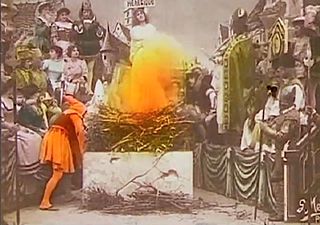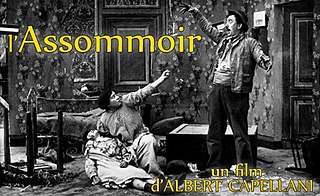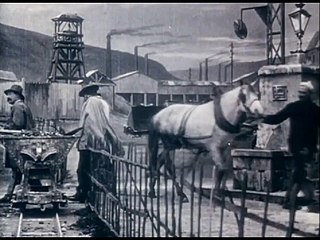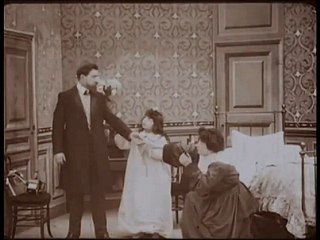
Joan of Arc is a 1900 French silent film directed by Georges Méliès, based on the life of Joan of Arc.

J'accuse is a 1919 French silent film directed by Abel Gance. It juxtaposes a romantic drama with the background of the horrors of World War I, and it is sometimes described as a pacifist or anti-war film. Work on the film began in 1918, and some scenes were filmed on real battlefields. The film's powerful depiction of wartime suffering, particularly its climactic sequence of the "return of the dead", made it an international success and confirmed Gance as one of the most important directors in Europe.

The Columbus Monument is a 60 m (197 ft) tall monument to Christopher Columbus at the lower end of La Rambla, Barcelona, Catalonia, Spain. It was constructed for the Exposición Universal de Barcelona (1888) in honor of Columbus' first voyage to the Americas. The monument serves as a reminder that Christopher Columbus reported to Queen Isabella I and King Ferdinand V in Barcelona after his first trip to the new continent.
Christopher Columbus was an Italian explorer and navigator from the Republic of Genoa.

Le Chevalier des Neiges, known in English as The Knight of the Snows or The Knight of the Snow, is a 1912 French silent trick film directed by Georges Méliès.
Christopher Columbus was an Italian explorer and navigator who completed four voyages across the Atlantic Ocean, opening the way for European exploration and colonization of the Americas. His expeditions, sponsored by the Catholic Monarchs of Spain, were the first European contact with the Caribbean, Central America, and South America. He has been represented in many fictional and semi-fictional works, including plays, operas, films and TV, as well as literary works.
Chris Columbus, Jr. is a 1934 short animated film by Walter Lantz Productions, starring Oswald the Lucky Rabbit. It is loosely based on the historic events leading to Christopher Columbus' sailing to the lands that were later named America. It is also among the few cartoons where Oswald plays a character other than himself.

Gérard Bourgeois was a leading French film director during the silent era.

L'Assommoir(English: The Drinking Den) is a 1909 French drama film directed by Albert Capellani, adapting the eponymous 1879 play by William Busnach et Octave Gastineau, itself based on the 1877 novel by Emile Zola. It is the first French feature-length film and the second produced by the Société cinématographique des auteurs et gens de lettres (SCAGL) [fr].
William Tell is a 1903 French silent short film directed by Lucien Nonguet and distributed in France by Pathé Frères. The original French title is Guillaume Tell. It is the first film adaptation of the eponymous play by Friedrich Schiller.

Drama in the Air, also known as Tragedy in Mid-Air, is a 1904 French silent short film directed by Gaston Velle and distributed in France by Pathé Frères. The original French title is Un drame dans les airs. It is loosely based on the novel A Drama in the Air by Jules Verne.

The Strike is a 1904 French silent short film directed by Ferdinand Zecca and distributed in France by Pathé Frères. The film depicts a strike in a factory violently repressed by the Gendarmerie.
Don Quixote, also known as Adventures of the Ingenious Hidalgo Don Quixote, is a 1903 French silent short film directed by Ferdinand Zecca and Lucien Nonguet. The film is the oldest surviving cinematographic adaptation of the eponymous novel by Miguel de Cervantes.

Au pays noir is a 1905 French silent short film directed by Ferdinand Zecca and Lucien Nonguet, and distributed in English-speaking countries under the titles In the Mining District, Down in the Coal Mines and Tragedy in a Coal Mine. The film is based on Emile Zola's novel Germinal.

La révolution en Russie, also known as Les événements d'Odessa and La révolte du cuirassée Potemkine is a 1905 French silent short film directed by Lucien Nonguet, and distributed in English-speaking countries under the titles Revolution in Russia and Revolution in Odessa. The film dramatises the re-enactment of events that had taken place a short time before in the context of the 1905 Russian Revolution and which would be the subject twenty years later of Sergei Eisenstein's celebrated film, Battleship Potemkin.

L'assassinat du grand-duc Serge, is a 1905 French silent short film directed by Lucien Nonguet, and distributed in English-speaking countries under the titles Assassination of the Grand Duke Serge and Assassination of the King of Serbia. The film is a docudrama dramatising the re-enactment of the assassination of Grand Duke Sergei Alexandrovich of Russia that had taken place a few months before in Moscow.

The Law of Pardon, is a 1906 French silent short film directed by Albert Capellani. It is a melodrama about a man getting a divorce from his wife for adultery and getting the custody of their child.

The Bell Ringer's Daughter, is a 1906 French silent short film directed by Albert Capellani. It is a melodrama about a young woman seduced and abandoned with her baby.

Aladdin and His Wonder Lamp, is a 1906 French silent trick film directed by Albert Capellani, inspired by the folk tale, "The Story of Aladdin; or, the Wonderful Lamp", first known in Europe through its 18th century populariser, Antoine Galland, who added the tale to his translation of One Thousand and One Nights. His version, the first appearance of Arabian Nights in Europe, was published as Les mille et une nuits, between 1704 and 1717. Galland had heard the "Aladdin" story from the Maronite traveller and storyteller Hanna Diyab, in Paris, probably in the French language. The film is the oldest surviving cinematographic adaptation of this tale.

Children's Reformatory is a 1907 French silent short film directed by Charles Decroix, inspired by the eponymous novel by Aristide Bruant.
















